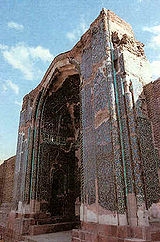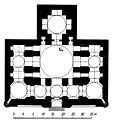
The Blue Mosque of Tabriz
Encyclopedia
The Blue Mosque is a famous historic mosque
in Tabrīz
, Iran
. The mosque and some other public buildings were constructed in 1465 upon the order of Jahan Shah
, the ruler of Kara Koyunlu
.
The mosque was severely damaged in an earthquake in 1779, leaving only the entrance iwan
. Reconstruction began in 1973 by the late Reza Memaran Benam under the supervision of Iranian Ministry of Culture. However, the tiling is still incompelete.

 The Blue mosque of Tabriz was built upon the order of Jahan Shah
The Blue mosque of Tabriz was built upon the order of Jahan Shah
the ruler of Kara Koyunlu
dynasty which made Tabriz the capital of his Kingdom. His Kingdom covered major parts of modern Iran, Azerbaijan, and Turkey. He was killed with Uzun Hassan
(ruler of Ak Koyunlu
) and buried on the nly parts of the mosque have survived.
The mausoleum was built in the southern section of the mosque and is entirely covered with high marble slabs on which verses from Quran are engraved in Thulth script on a background of fine arabesques. The roof of the mausoleum and the main dome chamber of the mosque collapsed during an earthquake in 1779 A.D. and was rebuilt in 1973 thanks to the efforts of Reza Memaran Benam (a famous architect from Tabriz) under the supervision of the national organization for preservation of ancient monuments.
Mosque
A mosque is a place of worship for followers of Islam. The word is likely to have entered the English language through French , from Portuguese , from Spanish , and from Berber , ultimately originating in — . The Arabic word masjid literally means a place of prostration...
in Tabrīz
Tabriz
Tabriz is the fourth largest city and one of the historical capitals of Iran and the capital of East Azerbaijan Province. Situated at an altitude of 1,350 meters at the junction of the Quri River and Aji River, it was the second largest city in Iran until the late 1960s, one of its former...
, Iran
Iran
Iran , officially the Islamic Republic of Iran , is a country in Southern and Western Asia. The name "Iran" has been in use natively since the Sassanian era and came into use internationally in 1935, before which the country was known to the Western world as Persia...
. The mosque and some other public buildings were constructed in 1465 upon the order of Jahan Shah
Jahan Shah
Muzaffar al-Din Jahan Shah ibn Yusuf was the leader of the Kara Koyunlu Turkmen tribal federation in Azerbaijan and Arran who reigned c.1438-1467. During his reign he managed to expand the Kara Koyunlu’s territory to its largest extent, including Western Anatolia, most of present day Iraq,...
, the ruler of Kara Koyunlu
Kara Koyunlu
The Kara Koyunlu or Qara Qoyunlu, also called the Black Sheep Turkomans , were a Shi'ite Oghuz Turkic tribal federation that ruled over the territory comprising the present-day Armenia, Azerbaijan, north-western Iran, eastern Turkey and Iraq from about 1375 to 1468.The Kara Koyunlu Turkomans at one...
.
The mosque was severely damaged in an earthquake in 1779, leaving only the entrance iwan
Iwan
An iwan is a rectangular hall or space, usually vaulted, walled on three sides, with one end entirely open. The formal gateway to the iwan is called pishtaq, a Persian term for a portal projecting from the facade of a building, usually decorated with calligraphy bands, glazed tilework, and...
. Reconstruction began in 1973 by the late Reza Memaran Benam under the supervision of Iranian Ministry of Culture. However, the tiling is still incompelete.
History


Jahan Shah
Muzaffar al-Din Jahan Shah ibn Yusuf was the leader of the Kara Koyunlu Turkmen tribal federation in Azerbaijan and Arran who reigned c.1438-1467. During his reign he managed to expand the Kara Koyunlu’s territory to its largest extent, including Western Anatolia, most of present day Iraq,...
the ruler of Kara Koyunlu
Kara Koyunlu
The Kara Koyunlu or Qara Qoyunlu, also called the Black Sheep Turkomans , were a Shi'ite Oghuz Turkic tribal federation that ruled over the territory comprising the present-day Armenia, Azerbaijan, north-western Iran, eastern Turkey and Iraq from about 1375 to 1468.The Kara Koyunlu Turkomans at one...
dynasty which made Tabriz the capital of his Kingdom. His Kingdom covered major parts of modern Iran, Azerbaijan, and Turkey. He was killed with Uzun Hassan
Uzun Hassan
Uzun Hasan or Hassan , Sultan of the Aq Qoyunlu dynasty, or White Sheep Turkmen. Hassan ruled in parts of present-day western Iran, Iraq, Turkey, Azerbaijan and Armenia between 1453 and 1478....
(ruler of Ak Koyunlu
Ak Koyunlu
The Aq Qoyunlu or Ak Koyunlu, also called the White Sheep Turkomans , was an Sunni Oghuz Turkic tribal federation that ruled parts of present-day Eastern Turkey, Armenia, Azerbaijan, northern Iraq, and Iran from 1378 to 1508.-History:According to chronicles from the Byzantine Empire, the Aq Qoyunlu...
) and buried on the nly parts of the mosque have survived.
The mausoleum was built in the southern section of the mosque and is entirely covered with high marble slabs on which verses from Quran are engraved in Thulth script on a background of fine arabesques. The roof of the mausoleum and the main dome chamber of the mosque collapsed during an earthquake in 1779 A.D. and was rebuilt in 1973 thanks to the efforts of Reza Memaran Benam (a famous architect from Tabriz) under the supervision of the national organization for preservation of ancient monuments.
Calligraphy
The diverse Kufic, and Thulth scripts, the exquisite arabesque patterns, and the admirable choramatic compositions of these facades, which are truly stupendous, were created by Nematollah-ben-Mohammad-ol-Bavab, the famous calligraphist. The walls (inside & outside) had been covered with mosaic tiles.See also
- List of Mosques in Iran
- Iron Age museumIron Age museumThe Iron Age Museum is a museum in Tabriz, north-western Iran, which covers an area of 28,290 m². It is located on the north, northwest and northeast of the Blue Mosque, situated under the several sediments and geological strata from the floor of the existing mosque.-History :Through the...
- Khaqani ParkKhaqani ParkKhaqani Park is a small park between Azerbaijan Museum and Blue mosque in Tabriz.- References :* * * http://www.tabrizcity.org...
- Iranian architectureIranian architectureIranian architecture or Persian architecture is the architecture of Iran . It has a continuous history from at least 5000 BCE to the present, with characteristic examples distributed over a vast area from Turkey to North India and the borders of China and from the Caucasus to Zanzibar...

